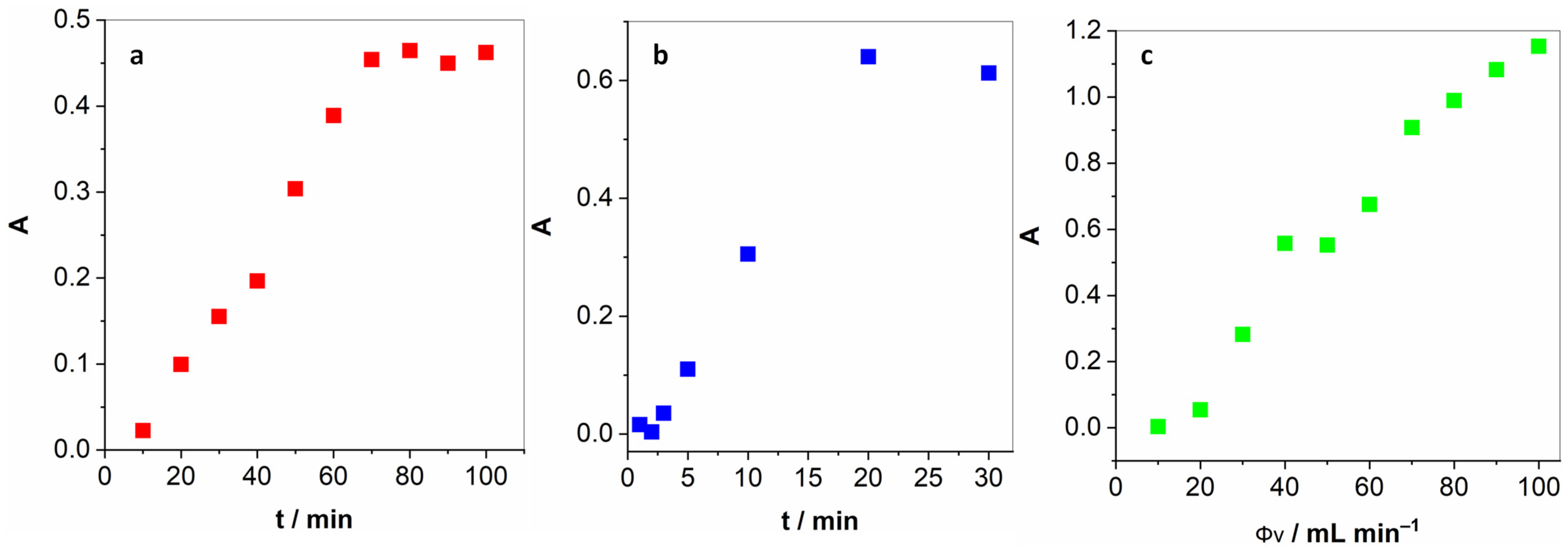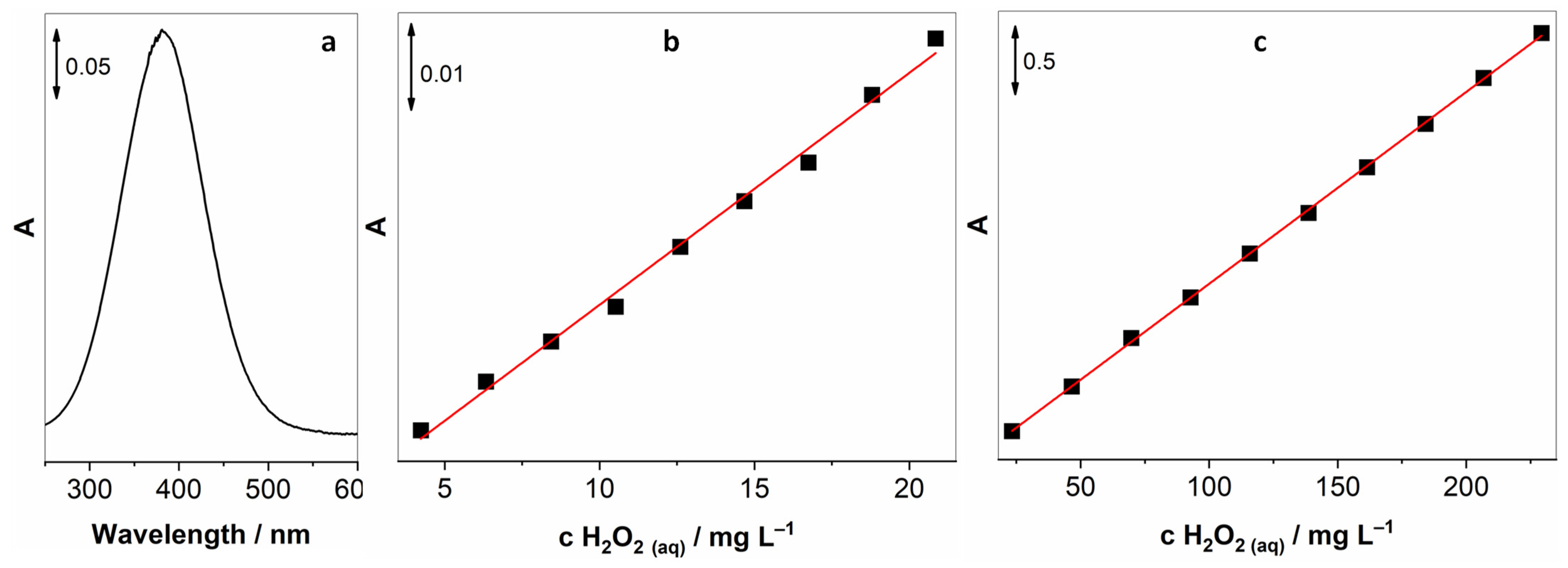Determination of Gaseous H2O2 Using UV-Vis Spectroscopy
Abstract
:1. Introduction
2. Experimental Section
2.1. Chemicals
2.2. Apparatus
2.3. Procedure
3. Results and Discussion
- H2O2 + 2 I− → I2 + 2 OH−
- I2 + I− → I3−
- 3.
- H2O2 → H2O + ½ O2
4. Conclusions
Supplementary Materials
Author Contributions
Funding
Data Availability Statement
Conflicts of Interest
References
- Klassen, N.V.; Marchington, D.; McGowan, H.C.E. H2O2 Determination by the I3- Method and by KMnO4 Titration. Anal. Chem. 1994, 66, 2921–2925. [Google Scholar] [CrossRef]
- Winterbourn, C.C. Chapter One-The Biological Chemistry of Hydrogen Peroxide. Methods Enzymol. 2013, 528, 3–25. [Google Scholar] [PubMed]
- Sies, H. Hydrogen peroxide as a central redox signaling molecule in physiological oxidative stress: Oxidative eustress. Redox Biol. 2017, 11, 613–619. [Google Scholar] [CrossRef] [PubMed]
- Rampon, C.; Vriz, S. Hydrogen Peroxide Signaling in Physiology and Pathology. Antioxidants 2023, 12, 661. [Google Scholar] [CrossRef]
- Vatansever, F.; de Melo, W.C.M.A.; Avci, P.; Vecchio, D.; Sadasivam, M.; Gupta, A.; Chandran, R.; Karimi, M.; Parizotto, N.A.; Yin, R.; et al. Antimicrobial strategies centered around reactive oxygen species–bactericidal antibiotics, photodynamic therapy, and beyond. FEMS Microbiol. Rev. 2013, 37, 955–989. [Google Scholar] [CrossRef]
- Andrés, C.M.C.; de la Lastra, J.M.P.; Juan, C.A.; Plou, F.J.; Pérez-Lebeña, E. Chemistry of Hydrogen Peroxide Formation and Elimination in Mammalian Cells, and Its Role in Various Pathologies. Stresses 2022, 2, 256–274. [Google Scholar] [CrossRef]
- Chan, H.P.; Lewis, C.; Thomas, P.S. Exhaled breath analysis: Novel approach for early detection of lung cancer. Lung Cancer 2009, 63, 164–168. [Google Scholar] [CrossRef]
- Teng, Y.; Sun, P.; Zhang, J.; Yu, R.; Bai, J.; Yao, X.; Huang, M.; Adcock, I.M.; Barnes, P.J. Hydrogen Peroxide in Exhaled Breath Condensate in Patients with Asthma: A Promising Biomarker? Chest 2011, 140, 108–116. [Google Scholar] [CrossRef]
- Kiss, H.; Örlős, Z.; Gellért, Á.; Megyesfalvi, Z.; Mikáczó, A.; Sárközi, A.; Vaskó, A.; Miklós, Z.; Horváth, I. Exhaled Biomarkers for Point-of-Care Diagnosis: Recent Advances and New Challenges in Breathomics. Micromachines 2023, 14, 391. [Google Scholar] [CrossRef]
- Sağlam, Ş.; Üzer, A.; Apak, R. Direct Determination of Peroxide Explosives on Polycarbazole/Gold Nanoparticle-Modified Glassy Carbon Sensor Electrodes Imprinted for Molecular Recognition of TATP and HMTD. Anal. Chem. 2022, 94, 17662–17669. [Google Scholar] [CrossRef]
- Ernstgård, L.; Sjögren, B.; Johanson, G. Acute effects of exposure to vapors of hydrogen peroxide in humans. Toxicol. Lett. 2012, 212, 222–227. [Google Scholar] [CrossRef] [PubMed]
- Chen, X.; Aoki, M.; Zhang, S.; Zhang, J.; Nozoe, S.; Komori, D.; Takami, A.; Hatakeyama, S. Observation of hydrogen peroxide concentrations in a Japanese red pine forest. J. Atmos. Chem. 2008, 60, 37–49. [Google Scholar] [CrossRef]
- Song, M.; Wang, J.; Chen, B.; Wang, L.; Facile, A. Nonreactive Hydrogen Peroxide (H2O2) Detection Method Enabled by Ion Chromatography with UV Detector. Anal. Chem. 2017, 89, 11537–11544. [Google Scholar] [CrossRef]
- Shin, G.-S.; Shin, H.-S. Determination of hydrogen peroxide in milk and coffee by gas chromatography-mass spectrometry after 4-iodo-2,6- dimethylphenol derivatization. J. Food Compos. Anal. 2025, 137, 106872. [Google Scholar] [CrossRef]
- Su, J.; Zhang, S.; Wang, C.; Li, M.; Wang, J.; Su, F.; Wang, Z. A Fast and Efficient Method for Detecting H2O2 by a Dual-Locked Model Chemosensor. ACS Omega 2021, 6, 14819–14823. [Google Scholar] [CrossRef]
- Eliasson, C.; Macleod, N.A.; Matousek, P. Noninvasive Detection of Concealed Liquid Explosives Using Raman Spectroscopy. Anal. Chem. 2007, 79, 8185–8189. [Google Scholar] [CrossRef]
- Bohrer, F.I.; Colesniuc, C.N.; Park, J.; Schuller, I.K.; Kummel, A.C.; Trogler, W.C. Selective Detection of Vapor Phase Hydrogen Peroxide with Phthalocyanine Chemiresistors. J. Am. Chem. Soc. 2008, 130, 3712–3713. [Google Scholar] [CrossRef]
- Majhi, S.M.; Mirzaei, A.; Kim, H.W.; Kim, S.S.; Kim, T.W. Recent advances in energy-saving chemiresistive gas sensors: A review. Nano Energy 2021, 79, 105369. [Google Scholar] [CrossRef]
- Gulaboski, R.; Mirčeski, V.; Kappl, R.; Hoth, M.; Bozem, M. Review—Quantification of Hydrogen Peroxide by Electrochemical Methods and Electron Spin Resonance Spectroscopy. J. Electrochem. Soc. 2019, 166, G82–G101. [Google Scholar] [CrossRef]
- Klun, U.; Zorko, D.; Stojanov, L.; Mirčeski, V.; Jovanovski, V. Amperometric sensor for gaseous H2O2 based on copper redox mediator incorporated electrolyte. Sens. Actuators Rep. 2023, 5, 100144. [Google Scholar] [CrossRef]
- Stojanov, L.; Rafailovska, A.; Jovanovski, V.; Mirceski, V. Electrochemistry of Copper in Polyacrylic Acid: The Electrode Mechanism and Analytical Application for Gaseous Hydrogen Peroxide Detection. J. Phys. Chem. C 2022, 126, 18313–18322. [Google Scholar] [CrossRef]
- Newman, L. Measurement Challenges in Atmospheric Chemisty; American Chemical Society: Washington, DC, USA, 1993. [Google Scholar]
- Dutta, A.; Maitra, U. Naked-Eye Detection of Hydrogen Peroxide on Photoluminescent Paper Discs. ACS Sens. 2022, 7, 513–522. [Google Scholar] [CrossRef] [PubMed]
- Yang, H.; Li, K.; Wang, Y.; Yuan, X.; Zhang, M. A label-free strategy for H2O2 assay by chemical vapor generation-atomic fluorescence spectrometry. Microchem. J. 2022, 183, 107965. [Google Scholar] [CrossRef]
- Ovenston, T.C.J.; Rees, W.T. The spectrophotometric determination of small amounts of hydrogen peroxide in aqueous solutions. Analyst 1950, 75, 204–208. [Google Scholar] [CrossRef]
- Noda, L.K.; Sensato, F.R.; Gonçalves, N.S. Titanyl sulphate, an inorganic polymer: Structural studies and vibrational assignment. Quim. Nova 2019, 42, 1112–1115. [Google Scholar] [CrossRef]
- Frew, J.E.; Jones, P.; Scholes, G. Spectrophotometric determination of hydrogen peroxide and organic hydropheroxides at low concentrations in aqueous solution. Anal. Chim. Acta 1983, 155, 139–150. [Google Scholar] [CrossRef]
- Hossain, R.; Dickinson, J.J.; Apblett, A.; Materer, N.F. Detection of Hydrogen Peroxide in Liquid and Vapors Using Titanium(IV)-Based Test Strips and Low-Cost Hardware. Sensors 2022, 22, 6635. [Google Scholar] [CrossRef]
- Bou, R.; Codony, R.; Tres, A.; Decker, E.A.; Guardiola, F. Determination of hydroperoxides in foods and biological samples by the ferrous oxidation–xylenol orange method: A review of the factors that influence the method’s performance. Anal. Biochem. 2008, 377, 1–15. [Google Scholar] [CrossRef]
- Patrick, W.A.; Wagner, H.B. Determination of Hydrogen Peroxide in Small Concentrations. Anal. Chem. 1949, 21, 1279–1280. [Google Scholar] [CrossRef]
- Sander, R. Compilation of Henry’s law constants (version 4.0) for water as solvent. Atmos. Chem. Phys. 2015, 15, 4399–4981. [Google Scholar] [CrossRef]
- Liang, C.; Huang, C.-F.; Mohanty, N.; Kurakalva, R.M. A rapid spectrophotometric determination of persulfate anion in ISCO. Chemosphere 2008, 73, 1540–1543. [Google Scholar] [CrossRef] [PubMed]







| Gaseous Interference | Presence | Relative Signal (%) |
|---|---|---|
| Oxygen | 0 (air) | 100 |
| 100% | 106 | |
| Nitrogen | 0 (air) | 100 |
| 100% | 93.5 | |
| Carbon monoxide (250 ppm in air) | 0 (air) | 100 |
| 250 ppm in air | 69.3 | |
| Hydrogen (30% in nitrogen) | 0 (air) | 100 |
| 30% in nitrogen | 94 | |
| Argon | 0 (air) | 100 |
| 100% | 159 | |
| Solvent vapours | ||
| Acetone | 0 (air) | 100 |
| 1000 mg m−3 | 95.5 | |
| Ethanol | 0 (air) | 100 |
| 1000 mg m−3 | 91.4 | |
| Reducing solutions | ||
| Sodium sulphide | 0 (air) | 100 |
| 10 g L−1 | /* | |
| Sodium sulphate(IV) | 0 (air) | 100 |
| 10 g L−1 | 57.8 | |
| Sodium nitrate(III) | 0 (air) | 100 |
| 10 g L−1 | 33.2 |
| Gaseous Interference | Presence | Relative Signal (%) |
|---|---|---|
| Oxygen | 0 (air) | 100 |
| 100% | 102 | |
| Nitrogen | 0 (air) | 100 |
| 100% | 101 | |
| Carbon monoxide (250 ppm in air) | 0 (air) | 100 |
| 250 ppm in air | 101 | |
| Hydrogen (30% in nitrogen) | 0 (air) | 100 |
| 30% in nitrogen | 100 | |
| Argon | 0 (air) | 100 |
| 100% | 132 |
| Parameter | Iodide Oxidation | Formation of Peroxo Titanium Complex |
|---|---|---|
| Pretreatment time | 20 min | 15 min |
| Optimum gas flow | 100 mL min−1 | 100 mL min−1 |
| Linear range | 0.4–17.6 mg m−3 | 10–90 mg m−3 |
| Correlation coefficient | 0.994 | 0.994 |
| Relative standard deviation | 5.2% | 8.5% |
| LoD | 0.70 mg m−3 | 3.96 mg m−3 |
| LoQ | 2.3 mg m−3 | 13.2 mg m−3 |
Disclaimer/Publisher’s Note: The statements, opinions and data contained in all publications are solely those of the individual author(s) and contributor(s) and not of MDPI and/or the editor(s). MDPI and/or the editor(s) disclaim responsibility for any injury to people or property resulting from any ideas, methods, instructions or products referred to in the content. |
© 2025 by the authors. Licensee MDPI, Basel, Switzerland. This article is an open access article distributed under the terms and conditions of the Creative Commons Attribution (CC BY) license (https://creativecommons.org/licenses/by/4.0/).
Share and Cite
Modic, A.; Filip, L.; Jovanovski, V. Determination of Gaseous H2O2 Using UV-Vis Spectroscopy. Chemosensors 2025, 13, 157. https://doi.org/10.3390/chemosensors13050157
Modic A, Filip L, Jovanovski V. Determination of Gaseous H2O2 Using UV-Vis Spectroscopy. Chemosensors. 2025; 13(5):157. https://doi.org/10.3390/chemosensors13050157
Chicago/Turabian StyleModic, Adam, Larisa Filip, and Vasko Jovanovski. 2025. "Determination of Gaseous H2O2 Using UV-Vis Spectroscopy" Chemosensors 13, no. 5: 157. https://doi.org/10.3390/chemosensors13050157
APA StyleModic, A., Filip, L., & Jovanovski, V. (2025). Determination of Gaseous H2O2 Using UV-Vis Spectroscopy. Chemosensors, 13(5), 157. https://doi.org/10.3390/chemosensors13050157




